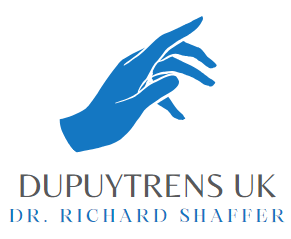There are a number of different treatment options for Dupuytren’s contracture. Our team are experts in treating the early stages of Dupuytren’s contracture with radiotherapy, a non-surgical approach that is proven to help prevent the permanent bending of your fingers.
Dupuytren’s disease treatments
At Dupuytren's UK, we’re specialists in treating the early stages of Dupuytren’s contracture with radiotherapy – a simple, safe and non-invasive treatment.
There are several options for you to consider when looking into effective treatments for this condition.
For early-stage Dupuytren’s contracture, when there is no fixed bending of the fingers, radiotherapy is an effective treatment option. Radiotherapy delivers low-dose X-rays to your fingers and palm to stop the nodules and cords growing, preventing the formation of a contracture.
Radiotherapy Treatment For Dupuytren's Contracture
We find radiotherapy is best at treating the early stages of progressive Dupuytren’s contracture – when there is minimal to no bending of your fingers and it has worsened over the last 12 months. This is in line with recommendations by The Royal College of Radiologists¹ stating that radiotherapy is effective in the early stage of Dupuytren’s contracture when there is a minor contracture of up to 10 degrees.
If your contracture is at an angle greater than 10 degrees, radiotherapy is less likely to be the best treatment for you and your doctor may recommend alternative options.
Dupuytren’s UK is one of the UK’s leading specialist centres for radiotherapy treatment with extensive experience in Dupuytren’s contracture and other benign diseases. We’ll advise you whether this treatment is likely to be effective for you depending on your stage of the disease.
¹ Source: The Royal College of Radiologists. A review of the use of radiotherapy in the UK for the treatment of benign clinical conditions and benign tumours. 2015. Retrieved from www.rcr.ac.uk Accessed: March 2020
Effectiveness of radiotherapy for Dupuytren's Contracture
A long-term follow-up of a study looked at the outcomes of patients who had received radiotherapy for progressive Dupuytren’s contracture and compared it with patients who chose to be observed rather than treated.² Significant reduction in disease progression and the need for surgery was found in the patients who received radiotherapy compared to the group who did not. Overall, patients who received radiotherapy for the treatment of Dupuytren’s contracture were more than three times less likely to see their condition progress or need surgery to release a contracture, when compared to those that chose to only have their condition observed. Results from the study can be seen in the table below.
The outcome of 8-year follow-up after radiotherapy for Dupuytren’s contracture:
| Patient Treatment | Improvement or no change in disease (%) | Worsening of disease (%) | Needed surgery for a contracture (%) |
| No radiotherapy | 38 | 62 | 30 |
| Radiotherapy | 60 | 20 | 8 |
² Seegenschmiedt, MH., Keilholz, L., Wielputz, M., Hanslian, E., Fehlauer, F., Long-term outcome of radiotherapy for early-stage Dupuytren’s disease: A phase III clinical study. In: Eaton, C., Seegenschmiedt, MH., Bayat, A., Gabbiani, G., Werker, P., Wach, W. (eds). Dupuytren’s disease and related hyperproliferative disorders. New York: Springer, 2012.
For late-stage Dupuytren’s, common treatments to release an established contracture include:
- Fasciectomy – a surgical cut is made along your palm and finger to straighten it
- Percutaneous fasciotomy (Needle aponeurotomy) – a needle is inserted into points along your palm and hand to release the cord and straighten your finger
